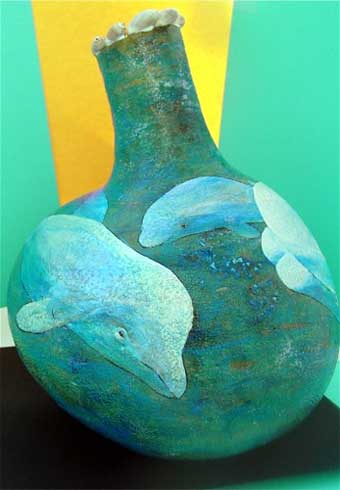Sea Ghost
Roll your mouse over the photo below
to see the other side of this gourd.

Friends of Gourds -
I have only seen these sea mammals on television,
although I would like to see them in real life
some day. That might not be easy to do, as
it seems that they like the frigid waters of
the Arctic, which is not Margie's main habitat.
Furthermore, many Beluga pods are endangered
thanks to human predation and polluted runoff,
including pesticides, that is found in the
estuaries where they breed. Other dangers that
confront them include disease, shipping vessel
traffic, seismic testing noise, decline of
their food (such as salmon) and other predators
such as the killer whale. The Beluga whale
looks to me to have all the mystery and elusiveness
of a ghost - and if we are not careful with
our environment they may in fact be with us
only as ghosts some day.
Beluga means "white one" in Russian,
and as far as I know I am the only one that has
called them 'sea ghosts'. Other folks refer to
them as sea canaries because they find their
way around through song (clicks, squeaks, whistles,
clangs...). They apparently use their song as
a means of finding their way around (echolocation)
because their tiny eyes are almost worthless.
That is why manmade noises, such as underwater
seismic testing, can jeopardize their safety.
The young belugas are apparently not white, however,
and in what I have read these young ghosts are
grey to reddish-brown. So this gourd has one
young Beluga (which probably only weighs about
140 lbs) and several adults.
Sea Ghosts is a nice sturdy gourd, decorated
with pyrography, leather dye, acrylic paint,
embossing powder -- and sea shells (why not?).
I will sell it for a donation to UNICEF, MORE,
or a nonprofit organization of your choice (as
long as it serves human rights, public health,
or the protection of the environment).
Enjoy spring.
top